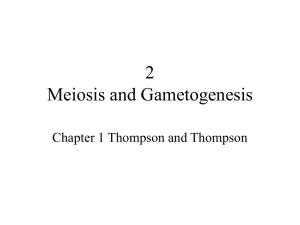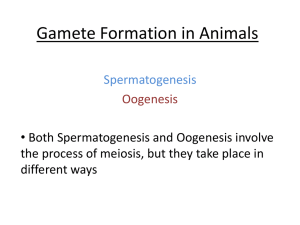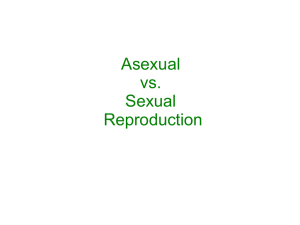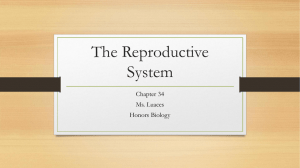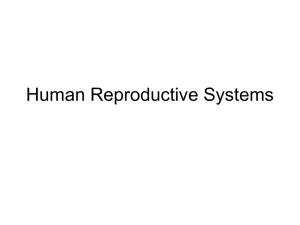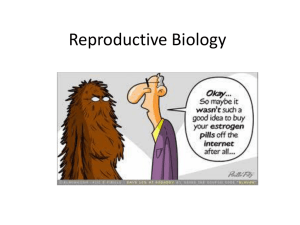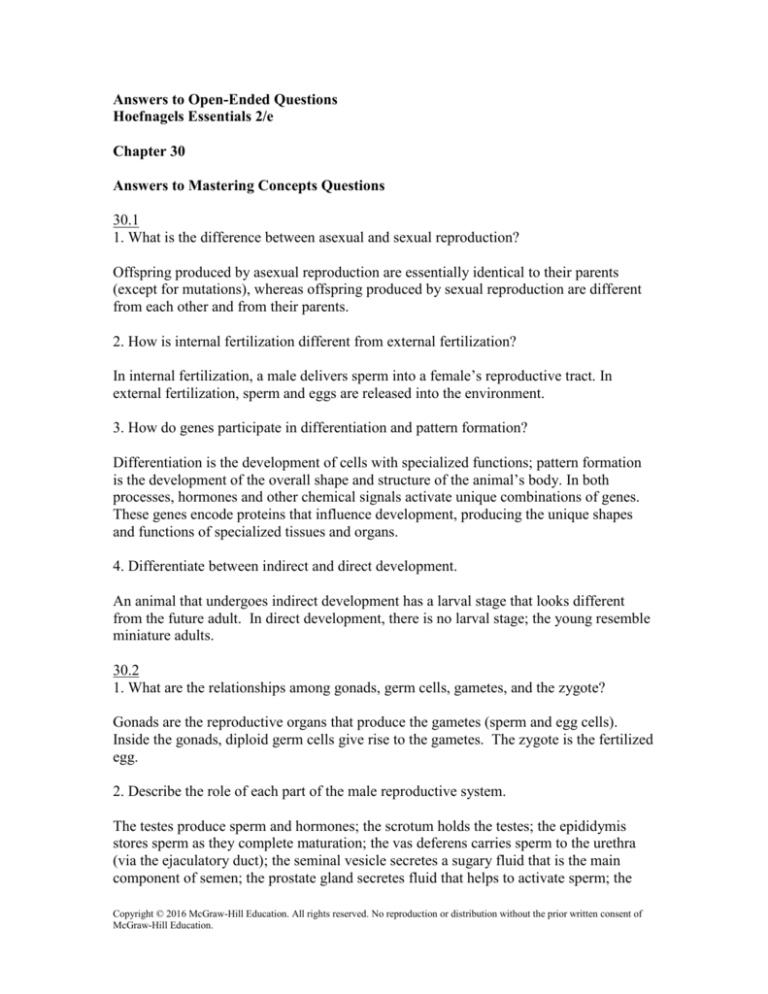
Answers to Open-Ended Questions
Hoefnagels Essentials 2/e
Chapter 30
Answers to Mastering Concepts Questions
30.1
1. What is the difference between asexual and sexual reproduction?
Offspring produced by asexual reproduction are essentially identical to their parents
(except for mutations), whereas offspring produced by sexual reproduction are different
from each other and from their parents.
2. How is internal fertilization different from external fertilization?
In internal fertilization, a male delivers sperm into a female’s reproductive tract. In
external fertilization, sperm and eggs are released into the environment.
3. How do genes participate in differentiation and pattern formation?
Differentiation is the development of cells with specialized functions; pattern formation
is the development of the overall shape and structure of the animal’s body. In both
processes, hormones and other chemical signals activate unique combinations of genes.
These genes encode proteins that influence development, producing the unique shapes
and functions of specialized tissues and organs.
4. Differentiate between indirect and direct development.
An animal that undergoes indirect development has a larval stage that looks different
from the future adult. In direct development, there is no larval stage; the young resemble
miniature adults.
30.2
1. What are the relationships among gonads, germ cells, gametes, and the zygote?
Gonads are the reproductive organs that produce the gametes (sperm and egg cells).
Inside the gonads, diploid germ cells give rise to the gametes. The zygote is the fertilized
egg.
2. Describe the role of each part of the male reproductive system.
The testes produce sperm and hormones; the scrotum holds the testes; the epididymis
stores sperm as they complete maturation; the vas deferens carries sperm to the urethra
(via the ejaculatory duct); the seminal vesicle secretes a sugary fluid that is the main
component of semen; the prostate gland secretes fluid that helps to activate sperm; the
Copyright © 2016 McGraw-Hill Education. All rights reserved. No reproduction or distribution without the prior written consent of
McGraw-Hill Education.
penis delivers sperm to the female’s body; the urethra carries semen (and urine) out of the
body.
3. Where in the testes do sperm develop?
Within the testes, sperm develop in seminiferous tubules.
4. What are the stages of spermatogenesis?
A diploid germ cell undergoes mitosis to form a diploid primary spermatocyte, which
undergoes meiosis. The product of meiosis I is a pair of haploid secondary
spermatocytes, and the product of meiosis II is four haploid spermatids. The spermatids
mature into sperm cells.
5. What are the parts of a mature sperm cell?
The parts of a mature sperm cell are the head (including the acrosome and nucleus), the
mitochondria in the section located just behind the head, and the flagellum.
6. How do hormones regulate sperm production?
The hypothalamus secretes gonadotropin releasing hormone (GnRH), which stimulates
the anterior pituitary to release follicle-stimulating hormone (FSH) and luteinizing
hormone (LH). LH stimulates endocrine cells in the testes to release testosterone and
other male sex hormones. Testosterone stimulates sperm production and production of
fluid by the prostate.
30.3
1. What is the role of each part of the female reproductive system?
The ovaries produce oocytes and hormones; the uterine tubes convey each oocyte to the
uterus; the uterus nurtures the developing baby; the endometrium is the inner lining of the
uterus; the cervix is the opening leading from the uterus to the vagina; the vagina is the
location where sperm are deposited and forms the birth canal; the clitoris is the main site
of sexual stimulation.
2. Where do egg cells develop?
Egg cells develop in the ovaries. They do not mature unless they contact sperm in the
uterine tube.
3. What are the stages of oogenesis?
A diploid germ cell undergoes mitosis to form a diploid primary oocyte, which undergoes
meiosis. The product of meiosis I is a haploid secondary oocyte (the egg cell) and a polar
Copyright © 2016 McGraw-Hill Education. All rights reserved. No reproduction or distribution without the prior written consent of
McGraw-Hill Education.
body. If sperm contacts the secondary oocyte, then it completes meiosis II, becoming a
mature egg cell briefly before fertilization completes.
4. What is the role of polar bodies in oogenesis?
Polar bodies allow for a single haploid egg cell to accumulate large amounts of cytoplasm
through the meiotic divisions of oogenesis.
5. How do hormones regulate the ovarian and menstrual cycles?
The hypothalamus secretes gonadotropin-releasing hormone (GnRH), which stimulates
the anterior pituitary to release luteinizing hormone (LH) and follicle-stimulating
hormone (FSH). At the ovaries, FSH stimulates the maturation of a follicle, and LH and
estrogen stimulate ovulation. The follicle then changes into a corpus luteum, which
secretes progesterone that maintains the uterine lining. If fertilization does not occur, the
corpus luteum stops producing estrogen and progesterone, and the uterine lining is shed
in menstruation.
6. List some side effects of hormone fluctuations in females.
Premenstrual syndrome (PMS) accompanies hormonal changes near menstruation;
menstrual cramps result from muscle contractions in the uterus; the estrogen withdrawal
that accompanies menopause is associated with hot flashes.
30.4
1. Describe how three birth control methods work.
[Answers will vary. Refer to Table 30.2.]
2. List and describe three common STDs.
Many answers are possible; here are three examples. (1) Genital warts are caused by
HPV (human papillomavirus). This virus can cause bumps on the external genitalia;
some strains cause cervical cancer. (2) Trichomoniasis is caused by a protozoan. Males
are usually symptomless, while females often produce a vaginal discharge and experience
pain and itching. (3) Chlamydia is caused by bacteria, which often causes pain and
burning upon urination in males and females.
3. Describe two reasons that a symptomless infection with an STD can be harmful.
A person may not seek medical attention for a symptomless infection, which may
eventually lead to infertility or cancer. Also, a symptomless individual will not know to
abstain from sex and may infect others unknowingly. STD infections also raise the risk of
contracting HIV.
Copyright © 2016 McGraw-Hill Education. All rights reserved. No reproduction or distribution without the prior written consent of
McGraw-Hill Education.
30.5
1. What are the events of fertilization?
The sperm approaches the egg cell and the sperm’s acrosome bursts, releasing enzymes
that digest the layers surrounding the egg cell. This allows the sperm cell membrane to
fuse with egg cell membrane. Then the sperm cell nucleus enters the egg cell and fuses
with its nucleus.
2. What are the relationships among the zygote, blastocyst, inner cell mass, and gastrula?
The zygote is the fertilized egg cell. The blastocyst is a hollow ball of cells whose inner
cells are called the inner cell mass. The inner cell mass develops into the three-layered
gastrula.
3. What is implantation, and when does it occur?
Implantation is the process by which the blastocyst becomes embedded in the
endometrium. It begins about a week after fertilization.
4. Which supportive structures develop during the embryonic period? What are their
functions?
Four membranes support the developing embryo: (1) The yolk sac makes blood cells
until the sixth week; (2) the allantois makes blood cells and produces blood vessels in the
umbilical cord; (3) the amnion cushions and protects the embryo from changes in
pressure and temperature; (4) the chorion helps establish the placenta. The placenta, in
turn, connects the embryo with the mother’s uterus via the umbilical cord.
5. When do sex differences appear, and what triggers them?
Sex differences begin to appear after the seventh week of development, when the sexdetermining gene on the Y chromosome switches on in a male embryo. This event
triggers the release of hormones that stimulate the development of male reproductive
organs and glands.
6. What are the events of the second and third trimesters?
In the second trimester, the fetus begins to take on the body proportions of a newborn;
eyebrows, lashes, nipples, and nails develop; bones begin to develop; and the fetus begins
to move around within the uterus. In the third trimester, the brain continues to develop;
other organs continue to differentiate and grow; fat is deposited beneath the skin; and the
fetus moves more vigorously.
7. Which events make up the three stages of labor?
Copyright © 2016 McGraw-Hill Education. All rights reserved. No reproduction or distribution without the prior written consent of
McGraw-Hill Education.
In the first stage, the amniotic sac breaks and the cervix dilates. In the second stage, the
baby is delivered through the cervix and vagina. The third stage is the delivery of the
placenta.
Write It Out
1. What are the advantages and disadvantages of asexual and sexual reproduction? Of
internal and external fertilization?
(1) Asexual reproduction produces identical clones of one individual and is advantageous
in an environment that does not change much over time. Sexual reproduction requires
two parents, each contributing to the DNA of the offspring. The genetic diversity
associated with sexual reproduction increases reproductive success in a changing
environment. (2) In internal fertilization, a male deposits sperm inside a female’s body.
The animals must spend energy to attract mates, but few gametes are wasted. In external
fertilization, males and females release gametes into the same environment, and
fertilization occurs outside the body. The animals may save the energy of finding a
specific mate (depending on the species), but many gametes are wasted.
2. How are the human male and female reproductive tracts similar, and how are they
different? How are the functions of the testis and ovary similar and different?
(1) Each system includes gonads (ovaries in females and testes in males) that contain the
germ cells that give rise to gametes. Each system also includes other sex organs, such as
the network of tubes that transport the gametes, although the exact organs differ between
the sexes. (2) Testes and ovaries are similar in that hormones control reproduction; in
addition, germ cells in the testes and ovaries produce gametes by meiosis. But the timing
and the details of the stages of spermatogenesis are different from those of oogenesis, and
the number of sperm produced in a lifetime is much greater than the number of oocytes
produced in a lifetime. Also, sperm develop in tubules, whereas egg cells emerge from
the ovary surface.
3. Briefly explain the contradictory roles of estrogen in the human female reproductive
cycle.
Increasing estrogen triggers the LH surge that cues ovulation. However, low estrogen
levels inhibit LH and FSH secretion.
4. How are the timetables different for oogenesis and spermatogenesis?
Oogenesis begins before a female is born, halts until puberty, and is not complete until
fertilization. In addition, oogenesis stops entirely at menopause. Spermatogenesis begins
when a male reaches puberty and lasts throughout his life.
Copyright © 2016 McGraw-Hill Education. All rights reserved. No reproduction or distribution without the prior written consent of
McGraw-Hill Education.
5. Suppose that a single ejaculate contains 240 million sperm cells. How many primary
spermatocytes must enter meiosis to produce this many sperm cells, and how many
secondary spermatocytes are produced along the way?
Meiosis begins with a diploid cell and yields four haploid cells. A primary spermatocyte
is the diploid cell that begins meiosis. Two secondary spermatocytes are the products of
meiosis I. Four immature sperm cells are the products of meiosis II. Therefore, 60 million
primary spermatocytes give rise to 120 million secondary spermatocytes, which in turn
give rise to 240 million sperm cells.
6. Point mutations usually occur during interphase of mitosis, but most chromosomal
abnormalities arise during meiosis. Given the differences between gamete production in
males and females, why is it reasonable to predict that more point mutations occur during
sperm production and more chromosomal abnormalities appear in egg cells?
Every male germ cell undergoes mitosis prior to undergoing meiosis; this process
maintains the number of germ cells in the testes. This mitotic division continues
throughout a male’s adult life, providing many opportunities for point mutations. In
females, mitosis occurs once in the germ cells prior to birth. From there every primary
oocyte in a follicle is in the process of meiosis, and mitosis will no longer occur. The
delay between the start and end of meiosis in females provides opportunities for
chromosomal problems such as nondisjunction to occur in oogenesis.
7. Is each of the following cell types haploid or diploid? How does each cell type relate to
the others?
a. A germ cell
b. A primary spermatocyte
c. A spermatid
d. A mature egg cell
e. A polar body produced at the end of meiosis II
The germ cell and primary spermatocyte are diploid; the spermatid, mature egg cell, and
polar body are haploid. A germ cell is a cell that undergoes mitosis, giving rise to two
primary spermatocytes (in males) or primary oocytes (in females); each primary oocyte,
in turn, undergoes meiosis to produce a secondary oocyte and a polar body. A primary
spermatocyte undergoes meiosis I to give rise to two secondary spermatocytes, which
complete meiosis II to produce four spermatids. If a mature sperm cell contacts a
secondary oocyte, then the secondary oocyte will complete meiosis II, yielding a mature
egg cell and another polar body.
8. Write a paragraph describing the path of sperm to egg, starting with sperm in the
epididymis.
During ejaculation, sperm cells leave the epididymis, travel through the vas deferens and
ejaculatory duct, pass near the seminal vesicle and prostate, and enter the urethra. During
Copyright © 2016 McGraw-Hill Education. All rights reserved. No reproduction or distribution without the prior written consent of
McGraw-Hill Education.
ejaculation, semen is ejected from the penis into the vagina. Sperm cells swim through
the uterus and into a uterine tube, where they may meet a recently ovulated egg cell.
9. Describe some of the most common contraceptives.
Contraceptives include barriers such as a condom and cervical cap; spermicides that kill
sperm; hormones in birth control pills, which block ovulation and implantation; behaviors
like abstinence and the fertility awareness method (no intercourse during fertile times);
devices that block implantation, such as the intrauterine device; and surgeries like tubal
ligations and vasectomies.
10. After ovulation, LH transforms the ruptured follicle into the corpus luteum. As LH
levels decline, the corpus luteum degenerates. However, if fertilization occurs, the
preembryo starts producing a hormone called hCG, which is similar in structure to LH
and prevents the corpus luteum from degenerating. Why is it adaptive for the preembryo
to maintain the corpus luteum?
The corpus luteum produces progesterone, which maintains the uterine lining and
prevents menstruation. If progesterone levels fall early in pregnancy, then the embryo
will be expelled during menstruation.
11. Use the Internet to learn more about sexually transmitted diseases. Choose one to
study in detail. What type of infectious agent causes the disease? What are the symptoms
and long-term consequences of infection? Is a treatment available? Who is most affected?
[Answers will vary]
12. This chapter used the term villus in describing part of the chorion; the same term
appeared in chapter 28’s description of the small intestine. How are the chorionic and
intestinal villi similar and different in structure and function?
In general, villi are small projections. Intestinal villi increase the surface area of the small
intestine; chorionic villi increase the surface area of exchange between embryo and
mother. The functions are different, in that intestinal villi transfer nutrients from the
small intestine to the circulatory system, whereas the chorionic villi exchange nutrients
and wastes between the circulatory system of the mother and the embryo.
13. For each of the following pairs of phrases, indicate if the first is greater than the
second, if the second is greater than the first, or if the two are equal.
a. The number of cells in the inner cell mass; the number of cells in a gastrula
b. The thickness of the endometrium after ovulation; the thickness of the endometrium
after menstruation
c. The number of eggs released from an ovary during each ovarian cycle; the number of
sperm released during ejaculation
d. The number of chromosomes in an egg cell; the number of chromosomes in a sperm
cell
Copyright © 2016 McGraw-Hill Education. All rights reserved. No reproduction or distribution without the prior written consent of
McGraw-Hill Education.
(a) A gastrula has more cells than the inner cell mass. (b) The thickness of the
endometrium is greater after ovulation than after menstruation. (c) The number of sperm
released during ejaculation is greater than the number of eggs released from an ovary
during one ovarian cycle. (d) The number of chromosomes in an egg cell equals the
number of chromosomes in a sperm cell.
14. Arrange these structures in order from youngest to oldest: gastrula, zygote, fetus,
blastocyst.
From youngest to oldest, the structures are zygote, blastocyst, gastrula, and fetus.
15. Provide a general explanation for why men have nipples. Hint: Figure 30.16 may
help.
Until week 7 of pregnancy, males and females follow the same developmental patterns.
One possible explanation is that the cells that eventually give rise to nipples are present in
both sexes, but they develop differently throughout the lives of males and females.
16. A zygote is a single cell whose weight is immeasurably small, yet after countless cell
divisions it develops into a newborn weighing approximately 3.5 kilograms. While in the
uterus, the developing infant obtains the atoms that make up its ever-increasing mass
from its mother. Where does the mother obtain these atoms?
The mother obtains atoms from the food she eats.
17. Fetal red blood cells contain a version of hemoglobin (an oxygen-binding protein)
that is slightly different from that in adult red blood cells. Given the relationship between
fetus and mother, which hemoglobin do you predict should have a higher affinity for
oxygen? Explain your answer.
Fetal hemoglobin should have a higher affinity for oxygen, so that oxygen that was
absorbed at the mother’s lungs will cross into the fetal circulatory system at the placenta.
18. An ectopic pregnancy occurs when the preembryo implants somewhere other than in
the uterus, such as in the uterine tube. Why do ectopic pregnancies always result in
miscarriage?
In a normal pregnancy, the embryo receives nutrients via the placenta, which forms in the
uterus. The placenta cannot develop if a preembryo implants somewhere other than in the
uterus. Any embryo that implants anywhere else would stop developing when it became
starved for nutrients.
19. List some of the causes of birth defects.
Copyright © 2016 McGraw-Hill Education. All rights reserved. No reproduction or distribution without the prior written consent of
McGraw-Hill Education.
Some causes of birth defects include genetic mutations, chromosomal abnormalities, and
certain substances or conditions in the mother’s body (including alcohol, caffeine,
cigarettes, drugs, incorrect vitamin levels, starvation, or viral infection).
20. What are the events of childbirth?
In the first stage of labor, the amniotic sac breaks and the cervix dilates as muscles in the
uterus contract. Muscle contractions continue with increasing frequency as labor
proceeds. The baby descends through the cervix and vagina during the second stage of
labor, and the mother’s body expels the placenta in the third stage of labor.
21. During labor, a baby may remain in the birth canal for hours. How does the baby not
suffocate during this time?
The baby is still connected to the placenta via the umbilical cord, so the baby still
receives nutrients and gases from the mother during birth. Respiratory gases (oxygen and
carbon dioxide) cross the placenta, allowing cellular respiration to continue in the baby.
22. Most physicians clamp and cut the umbilical cord immediately after birth, separating
the baby from the nutrients and respiratory gases it receives from the placenta; other
physicians wait to cut the cord for several minutes after birth, allowing the remaining
cord blood to enter the baby’s body. Design an experiment to test whether immediate
clamping or delayed clamping of the umbilical cord is better practice for healthy babies.
Answers will vary. One approach would be to identify several women with healthy
pregnancies. After birth, half of the physicians should immediately clamp and cut each
baby’s umbilical cord, while the other half should wait for several minutes before cutting
the cord. The dependent variable of this experiment could be the number of
complications that each newborn developed after birth.
23. Some newborn mammals can walk and carry out other life functions independently.
Human babies, on the other hand, are born helpless. Speculate about the trade-offs in
these two reproductive strategies. What selective forces might limit the stage of
development at which humans are born?
In animals that form herds, offspring young that can walk soon after birth can keep up
with the group. Greater independence at birth also allows newborns to avoid some
predators, even when parents cannot protect them. However, the mothers of these young
must carry them inside their bodies until they are completely developed. This may put the
mother in a weakened state for a longer period of time than mothers in species that give
birth to underdeveloped young. Completely developed young are also larger than
underdeveloped young. In humans, the size of a newborn’s head is a selective force
limiting the stage of development at which babies are born.
Copyright © 2016 McGraw-Hill Education. All rights reserved. No reproduction or distribution without the prior written consent of
McGraw-Hill Education.
24. Use this textbook or the Internet to learn more about human cloning and stem cell
therapies. How does each topic relate to human reproduction and development? Why are
these techniques controversial?
Human cloning would mean transferring the diploid nucleus of a donor cell into a
denucleated egg cell. The cell would then be stimulated to divide and begin development
before being implanted into a woman’s uterus. Stem cells can be extracted from a
preembryo and chemically stimulated to divide and develop into different tissues or
organs. The techniques are controversial because many people think it is unethical to
clone a human, perhaps because the process is “unnatural” or because the resulting child
may have unforeseen problems. Similarly, many people feel that destroying a human
preembryo to harvest its stem cells is unethical.
Pull It Together
1. Add ovulation to the concept map. What hormonal changes typically accompany
ovulation? Add those hormones to the concept map as well.
“Ovulation” connects with “is the release of one or more” to “egg cells.” “Fertilization”
connects with “may occur soon after” to “ovulation.” Ovulation is accompanied by a shift
in estrogen, LH, and FSH. “Estrogen” connects with “rises in blood concentration
immediately before” to “ovulation.” “LH” and “FSH” connect with “rise in blood
concentration during” to “ovulation.”
2. Write into the concept map the approximate time after fertilization that each of the
following structures is present: preembryo, embryo, fetus, newborn.
A preembryo is present for the first two weeks after fertilization. After gastrulation (at
about day 14), the preembryo is considered an embryo. The embryo becomes a fetus at
the end of the eighth week. The transition between fetus and newborn is birth, which
typically occurs around week 38.
3. Add the terms placenta, follicle, polar body, gonad, gametes, meiosis, and mitosis to
this concept map.
“Placenta” connects with “develops during the” to “embryonic” stage. “Follicle”
connects with “surrounds the” to “egg cells.” “Polar body” connects with “is produced
during” to “oogenesis.” “Testes” and “ovaries” connect with “are” to “gonads.” “Sperm
cells” and “egg cells” connect with “are” to “gametes.” “Sperm cells” and “egg cells”
connect with “develop by” to “meiosis.” “Zygote” connects with “develops by” to
“mitosis.”
Copyright © 2016 McGraw-Hill Education. All rights reserved. No reproduction or distribution without the prior written consent of
McGraw-Hill Education.



